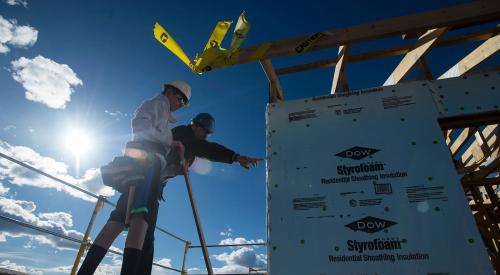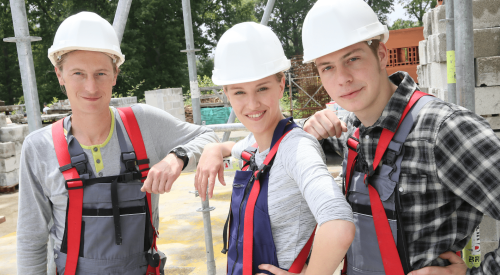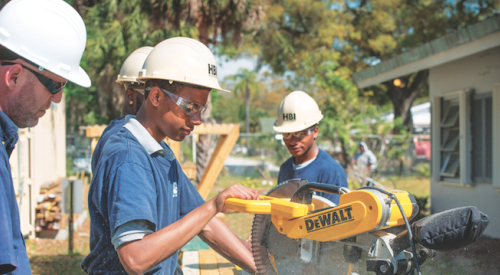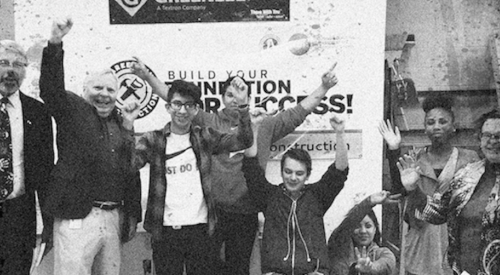The labor crisis has affected every home builder in some way, and in rural Dublin, Va., the need for skilled workers is especially keen. Thanks to people like Peter Anderson, though, students at a Dublin high school are getting the training they need to become productive members of the labor force.
Anderson is one of thousands of school teachers who belong to Skills USA-VICA, a national organization serving nearly 250,000 high school and college students and instructors enrolled in training programs in technical, skilled and service occupations. He has been teaching the four-year Building Trades program at Pulaski County High School (the only program of its kind in the entire state) since 1996. Anderson was instrumental in starting the local Skills USA-VICA chapter. He also was totally insistent—not to mention persistent—that local home builders play a role in the program.
Skills USA-VICA provides quality education experiences for students in leadership, teamwork, citizenship and character development, and helps students build and reinforce self-confidence, work attitudes and communication skills. "It’s life-changing for kids," says Anderson, who has been involved with the organization since 1988. For his outstanding work as a Skills USA-VICA instructor, and for his commitment to creating opportunities for youth, Professional Builder is honoring Peter Anderson with an Achievement Award.
Building Together
The Building Trades program is guided by a 15-member advisory committee that includes local suppliers, trade contractors and builders. Some committee members provide financial aid, while others donate materials or act as guest speakers and mentors to the students. For example, a home builder might give a presentation on the proper way to install vinyl windows or host a discussion on the career path in home building. When a builder speaks, students listen, says Anderson: "It creates immediate interest."
Builders also serve as judges for TeamBuild USA, a competition that tests the masonry, carpentry, electrical, plumbing and business organizational skills of four people who must work together as a team to complete an assigned building task. Contestants have to schedule a project, estimate materials, make a verbal presentation and build the project.
The first TeamBuild competition took place in July of last year. Ten teams, involving 40 students and their instructors, had to plan and construct a completely functional modular kitchen from start to finish in just two days. The key to winning the event was communication and teamwork among the members skilled in specific trade disciplines—not something always found on builder job sites today. The sight of all these eager students working together was enough to give hope to any home builder disheartened by the nationwide shortage of labor.
Firm Foundation
In the first year of the Building Trades course, students learn job safety, basic math skills (particularly fractions) and the proper use of hand and power tools. They also get a thorough introduction to the four core skill areas: masonry, carpentry, electricity and plumbing. Instruction is also given in other essential tasks such as reading blueprints, estimating, job cost planning, accounting and managing a small business.
Anderson devotes 4-1/2 weeks to each trade, and doesn’t skip the fundamentals: "I’ll show them how to drive a nail if necessary. If they need to spend some time pounding nails into a 2-by-4, that’s what we do." By their fourth and final year, students are building a modular house. This year’s senior class is building a 1400-square-foot home.
All students in the Building Trades program also participate in Skills USA-VICA’s Professional Development program, which teaches employability skills such as goal setting and career planning.
"It’s not enough for kids to learn just the academic and technical skills; they also need training on the traits and skills that make them employable, such as being on time and being trustworthy," Anderson says.
Thanks to ongoing financial support from the local building industry and business community, Building Trades has acquired some valuable resources. Instead of just a few carpentry and masonry tools, the shop and classroom are now equipped with the latest pneumatic nailers, laser levels and state-of-the-art electrical and plumbing tools. There are also computers, printers, scanners and a digital camera. Classroom lectures are supplemented by demonstrations, group activities and construction videos.
"The hands-on portion of the class has more ‘live’ work now that isn’t torn down after being constructed," Anderson says. "Students have more pride in their work if they know the project is something real." Anderson also periodically organizes field trips to area businesses and contractors.
The award-winning teacher discovered his true calling when he was a paratrooper and educator in the U.S. Army. He is a licensed electrician and contractor, and was once a supervisor for a modular home builder in Dublin. Anderson received a Bachelor of Science degree in education from Virginia Tech in 1996 while working full-time as a master electrician.
"Some counties in Virginia have been shutting down construction training programs," he says. "My new goal is to take seed money, buy a tract of land, subdivide it and start building houses with student help. In addition to the homes, there may be a Magnet Center on-site with a regional training facility for kids who want to learn construction. Eventually they would get to the point where they could design plans, do estimates... the whole process from start to finish. It would be a real student construction company."
Adults are interested in the high school’s program because the local community college offers instruction only in the electrical trades. "So there’s a potential for night classes as well," Anderson says.
There are approximately 80 students in the Building Trades program at any given time, with 18 graduating, on average, each year. They usually go on to private-sector construction jobs or enroll in the Virginia Department of Labor’s apprenticeship program. Placement rates for graduates have increased from 85 percent in 1996 to 94 percent in 1999. Some start working while they’re juniors and seniors. "This gives them the opportunity to shadow, mentor, communicate, learn, team up and figure out early in life if this is something they want to pursue as a career."
In addition to writing the Building Trades curriculum, Anderson is on the board of directors of the Virginia Skills USA-VICA and chairs various local, district and state skills and leadership events. He encourages all builders to get involved in their local Skills USA-VICA chapter. "Go to the teachers or administrators at your local high schools and colleges and see what programs are being offered and how you can help. It will be time well-spent."
To demonstrate the program’s effectiveness, Anderson relates the tale of Aaron Morris, a 1999 graduate of the Building Trades program. Morris, who was physically frail and nervous when he began the course, now tells people that Skills USA-VICA changed his life. The young man developed into an outstanding speaker and was named the 1999-2000 national president of Skills USA-VICA. Following in Anderson’s footsteps, Morris plans to become a building trades teacher.
Also See:
Giving Hope
Technology’s Fast Track
Better Houses
Sustainable Partners












